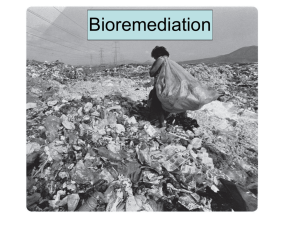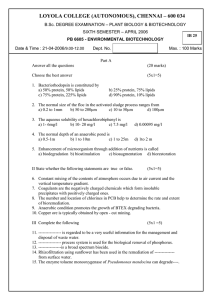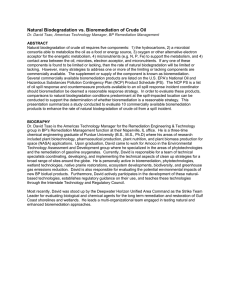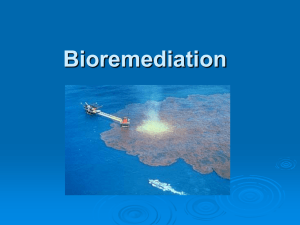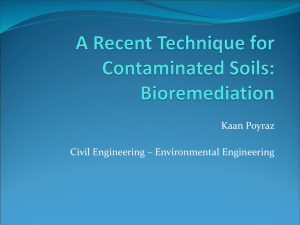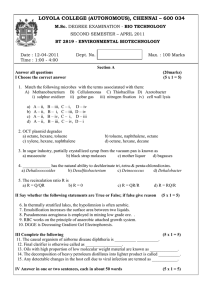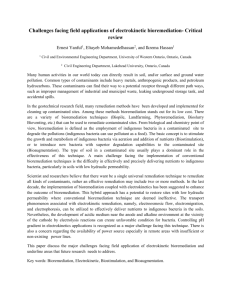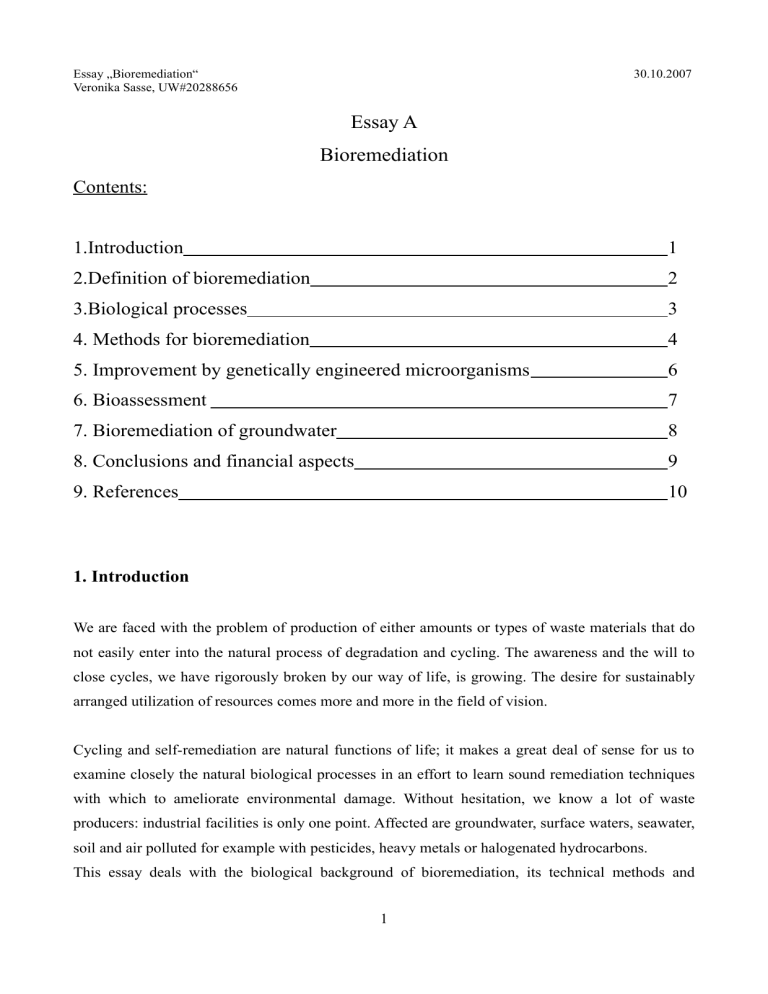
Essay „Bioremediation“ Veronika Sasse, UW#20288656 30.10.2007 Essay A Bioremediation Contents: 1.Introduction 1 2.Definition of bioremediation 2 3.Biological processes 3 4. Methods for bioremediation 4 5. Improvement by genetically engineered microorganisms 6 6. Bioassessment 7 7. Bioremediation of groundwater 8 8. Conclusions and financial aspects 9 9. References 10 1. Introduction We are faced with the problem of production of either amounts or types of waste materials that do not easily enter into the natural process of degradation and cycling. The awareness and the will to close cycles, we have rigorously broken by our way of life, is growing. The desire for sustainably arranged utilization of resources comes more and more in the field of vision. Cycling and self-remediation are natural functions of life; it makes a great deal of sense for us to examine closely the natural biological processes in an effort to learn sound remediation techniques with which to ameliorate environmental damage. Without hesitation, we know a lot of waste producers: industrial facilities is only one point. Affected are groundwater, surface waters, seawater, soil and air polluted for example with pesticides, heavy metals or halogenated hydrocarbons. This essay deals with the biological background of bioremediation, its technical methods and 1 Essay „Bioremediation“ Veronika Sasse, UW#20288656 30.10.2007 opportunity to improve the degradation by genetically engineered microorganisms. It describes the bioassessment of contaminated grounds. An example is given by introduction to bioremediation of groundwater. Last, financial and econimical aspects are considered. 2. Definition of Bioremediation In simple words, bioremediation is a process of environmental improvement, in which organisms play a key role. Organisms adapt to their surrounding conditions over the time. So, many microorganisms developed a way to use certain environmental pollutants as food sources and finally, to obtain energy. Bioremediation uses living systems or biological products to biodegrade anthropogenic waste, with the objective being reduction of waste to chemical forms that can be assimilated into natural cycles (Bonaventura et al. 1996). It leads to actual reduction and detoxification of wastes, ideally degraded to CO2 and water, when there are organic compounds. The goal of bioremediation is to biotransform toxic materials into nontoxic ones and to make accumulating anthropogenic waste enter natural biogeochemical cycles more quickly. 3. Biological processes Biodegradation of organic chemicals is accomplished enzymatically. Either the enzymes work internally or externally. The waste can be absorbed and broken down internally or it is treated by the secreted enzymes outside the microorganism. Therefore, cometabolism plays a role when microbial enzymes, produced for breaking down normal food sources may fortuitously degrade certain wastes, that are present as well. Specificity is a great characteristic of enzymes (that is why we love them), but some of them are not very specific. For example, oxygenases often fortuitously oxidize methane or toluene (Rittmann et al. 2002). We take advantage of cometabolism to biodegrade compounds, that otherwise would remain persistent in the environment. Some toxic compounds can be used as primary electron donors for energy and growth and some are transformed as electron acceptors. Halogenated organic compounds were recognized as potential electron acceptors in energy metabolism. There are different ways, wastes are degraded by microbes, which generally can be divided into aerobic and anaerobic metabolism. 2 Essay „Bioremediation“ Veronika Sasse, UW#20288656 30.10.2007 Bacteria that are able to degrade alkanes and polyaromatic compounds in the presence of oxygen are Pseudomonas, Alcaligenes, Sphingomonas, Rhodococcus and Mycobacterium. They have been applied for bioremediation of pesticides (Vidali, 2001). Removal of NH4+ by nitrifying bacteria and denitrification of NO3-/NO2- to N2 are known processes that support the reduction of those compounds. Also the phosphorus removal (phoshorus leads to eutrophication of lakes) is an important aerobic degradation carried out by certain heterotrophic bacteria (Rittmann et al.2002). Some microorganisms are capable of storing energy in forms of intracellular polyphosphate. So, this is a removal of phosphorus from the environment by biomass uptake. Anaerobic treatment can take place via methanogenesis, where organic matter is reduced to methane. This method is used for stabilization of municipal wastewater sludges and solid wastes. One big advantage of methanogenesis is methane as useful endproduct. It has been applied for heating and generating electrical power. Another important point is the low nutrient requirement for anaerobic degradation. On the other hand, methanogenesis has disadvantages like the low growth of microorganisms (they have usually doubling times of several days), odor production and higher buffer requirements for pH control. How is the process of methanogenesis working? First, carbohydrates, proteins and fats are converted into simple carbohydrates, amino acids and fatty acids (Rittmann et al.2002). These compounds yield energy for growth of the fermenting bacteria. The molecules are further degraded to organic acids and hydrogen. The next step is production of acetic acid and hydrogen, which are substrates for methanogens. They convert it into methane. Anaerobic bacteria have been reported to degrade halogenated hydrocarbons, but are not as frequently used as aerobic bacteria. In the absence of oxygen, for example, anaerobic degradation of chlorobenzoate to benzoate takes place by dechlorinator strain DCB-1. Another organism in this food chain, a benzoate degrader BZ2, ferments benzoate to 3 mol acetate, hydrogen and carbon dioxide. Methanospirillum strain PM-1 is able to reduce carbon dioxide to methane and water (Dolfing et al.1987). Two other groups of degrading microorganisms are ligninolytic fungi and Methylotrophs (King et al.1992). Methylotrophs grow on mediums with methane as carbon and energy source, because they have methane monooxygenase as initial enzyme. 3 Essay „Bioremediation“ Veronika Sasse, UW#20288656 30.10.2007 4. Methods for Bioremedation For degradation it is necessary, that bacteria and the contaminants are in contact. The methods applied for bioremediation are in situ remediation, use of filters and bioreactors as the three theoretical categories (Bonaventura et al. 1996). 1. in situ Remediation means in place, without excavation of the soil. This is the most desirable option due to lower cost and less disturbance. in situ land treatment: this is bioremediation of contaminated soil and associated groundwater. The site conditions are manipulated by inoculation with degrading microorganisms, modification of pH and mixing or aeration. If appropriate organisms are not present, they may be introduced into the environment, a technique called bioaugmentation (Rittmann, McCarty, 2002). A related problem with this kind of bioremediation is, that the effect on ambient conditions is hard to control. In situ treatment is limited by the depth of the soil that can be effectively treated. Land farming treats contaminated soil, liquids, sludges and solids. Wastes are sprayed onto, plowed into or mixed with surface soils. The method is improved by nutrient enrichment, addition of water and aeration for a better growth of microorganisms. The excavation of soil and redistribution into the surface layer gives greater access and opportunity for various biodegradation enhancement measures. Combination of nonbiological and biological methods is known to be very effective. Land farming approach differs from true bioreactors in that the waste is treated in solid phase, it is largely uncontained during treatment, and biodegradation organisms and pathways are generally limited to those that occur in situ (Bonaventura et al. 1996). 2. Biofiltration is a way to clean gaseous and liquid streams. Filters concentrate pollutants and/or biodegrade them to a nontoxic form. A biofilter can contain immobilized enzymes. An opportunity to immobilize enzymes is to embed them in a permeable membrane. In trickling filters and biofilters, the microorganisms are immobilized on a carrier or packing medium (Rittmann, McCarty, 2001). The bacteria are mainly dispersed in the circulating liquid. Slow biofiltration requires substantial land surface areas with microbiological activity in a small bed depth. The advantage of slow filtration is the less headloss buildup. Trickling filters are packed-bed reactors in which the wastewater trickles over the rock or plastic media. Passage of air is possible, so that oxygen can be transferred to the microorganisms throughout the reactor. 4 Essay „Bioremediation“ Veronika Sasse, UW#20288656 30.10.2007 The biofiltration process is based on two principles. Transfer of contaminants from the air to the water phase and the bioconversion of pollutants to biomass, metabolic endproducts or carbon dioxide and water. An application of biofiltration has been the removal of volatile organic compounds from air (Malhautier et al., 2005). Based on firstly transfer of contaminants from the air to the water phase, and secondly conversion by microbes. Highest removals are achieved for compounds, that have a high water solubility and ability to be biodegraded. Some substances are also treated well, although they are insoluble in water. This shows, that biofilm transport works even better than thought. Solubility of hydrophobic compounds like hexane is in water-biofilms, that contain biomass and organics, greater than in water. The size of particles and their features play an important role in choosing the right packing material for the biofilter. The amount of water is essential for both biofilm survival and microbial activity. The recommended water content is around 50% of the water-holding capacity of the material. The inoculum source is usually derived from activated sludge, but also from contaminated road-side soil or compost. The advantage of activated sludge from wastewater plants is the high number of different biodegrading species that allows a high potential ability to degrade a wide range of pollutants (Wagner et al. 2002). Biofiltration of less biodegradable compounds in the air could be improved based on cometabolic processes. 3. Bioreactors are much faster means of waste biodegradation. Of course, they belong to the ex situ way of bioremediation. You get a better control over the reaction conditions and the bacterial growth can be optimized. Bioreactors entail usually higher costs for equipment and require better knowledge of composition of waste and degradation pathways, so that this may be difficult (Bonaventura et al. 1996). One example for the application of a membrane bioreactor to degrade chlorinated compounds has been described by Carucci et al., 2007. Chlorinated hydrocarbons in pesticides pollute the groundwater and have serious effects for human health. Activated slugde obtained from a reactor of the municipal wastewater plant „Is Arenas in Cagliari“ (Italy) was used to aerobically degrade 2Chlorophenol (2-CP). The membrane bioreactor couples an ultrafiltration membrane module with a suspended biomass reactor. The extent of degradation was in this case 8,1mg 2-Chlorophenol (l*d) and for Phenol 81,4 mg/l*d in a batch test. They reached a twenty times higher rate of degradation than in former studies. Interesting is, that phenol is a necessary co-metabolite for 2-CP oxidation. When the concentration of phenol decreased under 4mg/l, the degradation of 2-CP was interrupted 5 Essay „Bioremediation“ Veronika Sasse, UW#20288656 30.10.2007 (Carucci et al. 2007). The minimum substrate concentration Smin has strong affects on biodegradation. Smin is defined as the lower threshold concentration, below which reaction speed is insufficient to supply the organism with sufficient energy for net growth (Rittmann, McCarty, 2001). Concentrations of synthetic compounds in drinking water is often less than Smin. However, this is a limiting condition for biodegradation. Anyway, degradation of this compound present below its Smin is possible, when it acts as secondary substrate to a compound present at higher concentrations (s. degradation of 2Chlorophenol by Carucci et al., 2007). Utilization of those secondary substrates also works when many compounds, that are present at concentrations less than Smin , are used simultaneously. Why do I mention minimum substrate concentration with regard to bioreactors? Bioreactors establish a treatment system, by which contaminants can be biodegraded below their Smin. As we know, a CSTR sets up continuous conditions and a continuous minimum substrate concentration as well. But a PFR is capable for reducing the Smin (depending on the travel time through reactor) below the threshold. This reduction is achieved by the biomass forming a biofilm in the plug-flow system. The biofilm reaches an accumulation of microorganisms in the reactor. 5. Improvement by genetically engineered microorganisms A natural process of adaptation to the environment of microorganisms is the opportunity to exchange genetic material. This is possible via conjugation, transformation and transduction. It is a horizontal gene transfer without reproduction. Plasmids can be transferred, that encode for enzymes, which are able to degrade specific contaminants and thereby, open a new source of energy for the receiving bacteria. Researcher are interested in how the gene transfer is induced. If we know more about this, we can control the gene transfer. For example Pseudomonas aeruginosa secretes surfactants, that solubilize oil. Genetically engineered microorganisms overproduce these surfactants, which are used for oil dispersants. At this place, only an overview of the genetic engineering process shall be given: the first step is the identification of the sequences, that code for proteins responsible for desired bioactivities. Next step is the replication and cloning of DNA by extracting it from original hosts. Recombinant techniques are used to introduce this genetic information into new host cells. 6 Essay „Bioremediation“ Veronika Sasse, UW#20288656 30.10.2007 To enhance bioremediation, microorganisms are transfected with genes, that improve their survival and competitiveness. A big advantage can be to attain a higher efficiency of oxygen absorption or to insert a tolerance for a higher concentration of heavy metals, that is too toxic for natural cultures. Microbes, that normally thrive in a given environment, could be transfected with degradative enzyme genes from bacterial species, that are good biodegraders, but poorly adapted to the environment of interest (Bonaventura et al. 1996). Operation with genetic engineered microbes brings about a certain amount of risk. The release of genetically engineered organisms and its effetcs is not completely understood. The first place for application of genetically engineered organisms is supposed to be bioreactors. 6. Bioassessment The basic information to enhance biodegradative processes is the knowledge of the microorganisms present in a given site and food substrates they prefer to use. Especially for in situ bioremediation an assessment of the conditions is essential. As mentioned above, the reaction of degradation is in some cases enhanced by adding needed materials. Therefore, it is necessary to know what nutrients are already present. There is the possibility to accomplish an initial assessment or a treatability study, that investigates kinetics and degradation pathways (King et al. 1992). In an initial assessment, average hydrocarbon content and specific compounds are measured. The specific hydrocarbon degrading population is estimated by an analysis of the different present microorganisms. Therefore a 16S and 23S rRNA library can be created. By FISH (i.e. fluorescent in situ hybridization), conclusions based on presence of active bacteria is possible. Other means for investigation of microbial population are gene fingerprinting techniques, microsensors and CLSM (i.e. confocal laser scanning microscope) ( Wilderer et al. 2002). Also important are BOD (biochemical oxygen demand), TOC (total organic carbon) and pH for wastewater. After that, soil and water are combined in flasks to determine the treatment duration and degree of degradation as well as oxygen consumption and nutrient content. These parameters are necessary to provide a degradation under ideal conditions. The next step can be a geochemical testing to determine the water/soil-system response to addition of nutrients and oxygen ( King et al. 1992). 7 Essay „Bioremediation“ Veronika Sasse, UW#20288656 30.10.2007 7. Bioremediation of groundwater The big problem at bioremediation of groundwater is, that it is mobile. People often use untreated groundwater for drinking. That justifies more drastic and expensive measures for cleaning the water. Usually, groundwater is pumped, treated and recharged into the aquifer. The treatment can include biological surface treatment, which is a way to degrade wastes in the mobile, aqueous phase. It must be pointed out, that most organic wastes are less water soluble. The organic contaminants often remain adsorbed to the soil matrix, float on the top or sink to the bottom of the water table. The rate of waste going into the groundwater is limited by diffusion. Pump-and-treat measures may reduce pollutant concentration in the aqueous phase, but when the pumps are switched off, the concentration of contaminants in the groundwater increases again. Thus, pump-and-treat is not the approved method for cleaning groundwater. Another bioremediation approach is subsurface in situ remediation. The water is enriched by nutrients and oxygen to stimulate aerobic biodegradation by indigenous bacteria. To increase the oxygen content of the groundwater, oxygen is added by air pumps or alternative oxygen sources such as hydrogen peroxide are used (Bonaventura et al. 1996). Dermietzel and Vieth investigated the chances of bioremediation of chloroaromatics in groundwater. The groundwater in Bitterfeld (Saxony-Anhalt) is heavily contaminated by monochlorobenzene (MCB) and 1,4-dichlorobenzene up to 50 mg/l. Both the laboratory experiments and on-site column tests showed, that biodegradation of MCB is only limited by a lack of oxygen. Microorganisms were able to mineralize up to 100mg/l MCB, when enough oxygen was available. When oxygen was added to the site, even higher reaction rates of aerobic degradation were reached than under laboratory conditions (Dermietzel, Vieth 2002). The amount of 1,4dichlorobenzene was decreased by anaerobic dechlorination. 8 Essay „Bioremediation“ Veronika Sasse, UW#20288656 30.10.2007 8. Conclusions and financial aspects In comparison to conventional remediation like excavation, pump-and-treat, or application of surfactants, systems based on bioremediation lead to an actual reduction of waste, because the toxic material is degraded. It is also used to concentrate or „bioaccumulate“ toxic material like heavy metals. Thus, the pollutants are easier to remove and potentially available in a form suitable for recycling. There is the potential for in situ remediation. This is a big advantage in contrast to excavation of large areas or volumes. When the toxic material has not to be transported anymore, it is not that hazardous for human health of the workers. Not to forget, that there are no toxic by-products or residues as nonbiological alternatives. On the other hand, bioremediation is limited to those compounds, that are degradable. Bioremediation often takes longer than other removal methods like excavation. There is no 100% cleaning possible, because substrate concentration must not be under a special value. Notice, applicability of bioremediation must be individually assessed for every contaminated site. There is no all-round concept. The public acceptance of bioremediation is high. But only methods are employed, that do no exceed an appropriate cost limit. Depending on how decisive the pollution is, people are willing to finance an investment or not. Some European countries, for example, attach great importance to drinking water. The standard for processing of drinking water is even higher than for industrial bottled water, because the legislature considers, that water is used for the lifelong consumption. In this case people are ready to pay much for the treatment of water. Bioremediation is applied heavily. At a comparison of costs between conventional methods and bioremediation, it should be kept in mind, that in case of in situ remediation costs for transport and excavation cease. In terms of sustainability, bioremediation has priority, because it leads to real reduction of waste and not only storage or displacement of pollutants. There is a hugh amount of substances we do not know how to degrade. What about hormones, that rise from residues of medicaments (e.g. birth control pill) and are present in soil and water? Does anyone care? They appear in extremely low concentrations but are nevertheless very effective on the environment. Of course, bioremediation is not yet optimized and needs to be improved by further research. 9 Essay „Bioremediation“ Veronika Sasse, UW#20288656 30.10.2007 9. References Bonaventura,C.,Bonaventura,J.,Bodishbaugh, D.F., 1996. Environmental Bioremediation: Approaches and Processes. Applications and new horizons. Ecotoxicity and human health. p.183-242 Carucci,A.,Manconi,I.,Manigas,L.2007.Use of membrane bioreactors for bioremediation of chlorinated compounds polluted groundwater.Water, Science and Technology.Vol55.No10.pp.209-216 Dermietzel,J.,Vieth,A.,2002. Chloroaromatics in groundwater: chances of bioremediation. Environmental Geology 41, p.683-689 Dolfing,J.,Tiedje,J.M.,1987.Growth yield increase linked to reductive dechlorination in a defined 3- chlorobenzoate degrading methanogenic coculture. Arch Microbiol.Vol.149.102-105 King,R.B.,Long,G.M.,Sheldon,J.K.1992.Practical Environmental Bioremediation.p.103-110 Malhautier,L.,Khammar,N.,Bayle,S.,Fanlo,J-L.,2005.Biofiltration of volatile organic compounds. Appl. Microbiol Biotechnol 68,p.16-22 Rittmann,B.E.,McCarty,P.L.2001.Environmental biotechnology:principles and applications Vidali,M.2001.Bioremediation.An overview. Pure Appl. Chem.,Vol.73,No.7,pp. 1163-1172 Wagner,M., Loy,A., Nogueira,R., Purkhold,U., Lee,N., Daims,H. 2002. Microbial community composition and function in wastewater treatment plants. Antonie van Leeuwenhoek 81.p.665-680 Wilderer,P.A.,Bungartz,H-J.,Lemmer,H.,Wagner,M.,Keller,J.,Wuertz,S.,2002. Modern scientific methods and their potential in wastewater science and technology. Water Research.Vol.36.p.370-393 10
